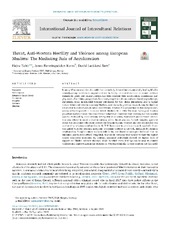| dc.contributor.author | Tahir, Hajra | |
| dc.contributor.author | Kunst, Jonas R. | |
| dc.contributor.author | Sam, David Lackland | |
| dc.date.accessioned | 2020-03-27T14:57:38Z | |
| dc.date.available | 2020-03-27T14:57:38Z | |
| dc.date.issued | 2019 | |
| dc.Published | Tahir H, Kunst JRK, Sam DL. Threat, anti-western hostility and violence among European muslims: The mediating role of acculturation. International Journal of Intercultural Relations. 2019;73:74-88 | eng |
| dc.identifier.issn | 1873-7552 | |
| dc.identifier.issn | 0147-1767 | |
| dc.identifier.uri | https://hdl.handle.net/1956/21621 | |
| dc.description.abstract | In many Western countries, the public has extensively debated factors potentially leading Muslim minority-group members to support violence by foreign extremist states or to commit violence themselves. Here, one central question has been whether their acculturation orientations may play a role. Combining perspectives from intergroup threat theory and acculturation psychology, the present study investigated whether one reason for why threat perceptions lead to higher violent behavioral intentions among Muslims, as evidence by previous research, may be that they are related to distinct acculturation orientations. It tested this proposition in two samples comprising of Norwegian (N = 253) and British Muslims (N = 194). The more Norwegian Muslims perceived realistic threat, the more violent behavioral intentions they showed, but this relation was not mediated by acculturation. Among British Muslims, mainstream acculturation orientation was related to more violent intentions, while threat was not. In both samples, symbolic threat was associated with more support for Muslim military violence and this relationship was mediated by religious acculturation in the U.K. In contrast to previous research, symbolic threat was linked with less personal intentions to commit violence in the U.K., mediated by religious acculturation. Complementary analyses calculating acculturation strategies indicated that assimilated, and to some extend integrated, Muslims in both countries tended to show the highest violent behavioral intentions. By contrast, separated individuals showed the highest level of support for Muslim military violence. Ways in which these findings can be used to counter violence and improve intergroup relations in Western ethnically diverse societies are discussed. | en_US |
| dc.language.iso | eng | eng |
| dc.publisher | Elsevier | eng |
| dc.rights | Attribution CC BY-NC-ND | eng |
| dc.rights.uri | http://creativecommons.org/licenses/by-nc-nd/4.0/ | eng |
| dc.title | Threat, anti-western hostility and violence among European muslims: The mediating role of acculturation | eng |
| dc.type | Peer reviewed | |
| dc.type | Journal article | |
| dc.date.updated | 2020-02-12T08:58:26Z | |
| dc.description.version | publishedVersion | |
| dc.rights.holder | Copyright 2019 The Author(s) | eng |
| dc.identifier.doi | https://doi.org/10.1016/j.ijintrel.2019.08.001 | |
| dc.identifier.cristin | 1724923 | |
| dc.source.journal | International Journal of Intercultural Relations | |
| dc.source.pagenumber | 74-88 | |
| dc.relation.project | Norges forskningsråd: 256205 | |
| dc.identifier.citation | International Journal of Intercultural Relations. 2019;73:74-88 | |
| dc.source.volume | 73 | |

